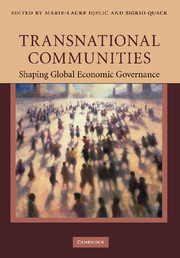Book contents
- Frontmatter
- Contents
- List of figures
- List of tables
- List of appendices
- Contributors
- Preface
- Part I Introduction
- Part II Classical communities with a transnational extension
- 3 The multiple layers of a transnational “imagined community”: the notion and reality of the ethnic Chinese business community
- 4 From cross-border exchange networks to transnational trading practices? The case of shuttle traders in Laleli, Istanbul
- Part III Professional communities with a transnational extension
- Part IV Virtual communities
- Part V Transnational interest- or issue-based communities
- Part VI Conclusion
- Index
- References
3 - The multiple layers of a transnational “imagined community”: the notion and reality of the ethnic Chinese business community
Published online by Cambridge University Press: 07 September 2010
- Frontmatter
- Contents
- List of figures
- List of tables
- List of appendices
- Contributors
- Preface
- Part I Introduction
- Part II Classical communities with a transnational extension
- 3 The multiple layers of a transnational “imagined community”: the notion and reality of the ethnic Chinese business community
- 4 From cross-border exchange networks to transnational trading practices? The case of shuttle traders in Laleli, Istanbul
- Part III Professional communities with a transnational extension
- Part IV Virtual communities
- Part V Transnational interest- or issue-based communities
- Part VI Conclusion
- Index
- References
Summary
Introduction
In this chapter I shall critically explore the notion and reality of a transnational Chinese community and its role in transnational business activity. Chinese businesspeople, whether of mainland or diasporic background and operating in the global economy have been constructed as a close-knit and far-flung transnational community (cf. Redding 1990; Castells 1996; Weidenbaum and Hughes 1996; Ong and Nonini 1997; Suryadinata 1997; Douw 1999; Ong 1999; Chan 2000; Yeung and Olds 2000; Yeung 2002; Coe et al. 2003; Gomez and Hsiao 2004). Ethnic affiliation and cultural affinity have been regarded as principles organizing flows of capital, goods, knowledge, and people within this transnational community and across national borders, superseding national differences. Management gurus such as Kotkin (1993) have identified ethnic ties – allegedly more sentiment-based than other forms of social relations – as key to Asian business success. Ethnic Chinese businesses in particular are regarded as spearheads of Asia's economic growth, as well as a major global force. As the story goes, the large Chinese diaspora, with its global presence, enjoys special privileges when it comes to business ventures across national borders in general and into mainland China in particular. Coupled with a capacity for hard work and trust based on a Confucian value system that honors blood ties and (ritual) kinship, the Chinese business community seems to be a distinguishing feature of Chinese in contrast to Western capitalism, and to have engendered economic success where others have failed (Redding 1990).
- Type
- Chapter
- Information
- Transnational CommunitiesShaping Global Economic Governance, pp. 57 - 81Publisher: Cambridge University PressPrint publication year: 2010
References
- 1
- Cited by



